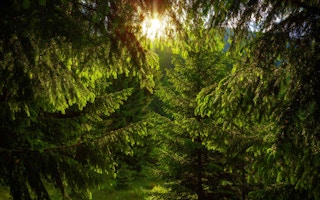A forest could be its own economic community as trees establish their own free trade area. They don’t just build their own tissues with atmospheric carbon, they also share it with the neighbours, according to new research.
Tree roots can graft to each other, but Swiss researchers have established that trees are sharing resources even when no such grafts take place.
Tamir Klein, a botanist at the University of Basel in Switzerland, and colleagues report in Science journal that up to 40 per cent of the fine root carbon in temperate forest trees may have been derived from the neighbouring trees.
The discovery that trees that compete for sunlight and growing space can also co-operate is, once again, an instance of the remarkable and sometimes puzzling complexity and interdependence of living things.
Simple science
And the scientists established their discovery with some simple but difficult-to-achieve science, based on elemental isotope comparisons − and a very large crane.
They used the crane to get to the canopies of spruce trees, 120 years old and 40 metres tall. Then they used a network of fine tubes to flood the crowns of these trees with their own labelled carbon dioxide. Their supplies of the greenhouse gas were conspicuously short of the proportion of the rare and heavy isotope carbon-13 that is normally detected in air.
This sudden flooding of the canopy made no difference to the experimental trees. They did what trees do and used photosynthesis to take the carbon from the air, and used the carbon to make sugars which then became cellulose, lignin, proteins and lipids in the plant tissues, not just in the leaves and stems but all the way down to the roots and the fungi around the roots.
And then the researchers used an atomic mass spectrometer to track the carbon through the entire tree. They found that their carbon not only spread through their prime specimens, but neighbouring trees – sometimes of different species – that had not been given the labelled carbon dioxide also turned out to have acquired an unexpected quantity of the experimental gas.
Carbon exchange
The only way the carbon could have been exchanged between spruce, beech, pine or larch, was by a network of tiny filaments belonging to the mycorrhizal fungi that traffic nutrients in the forest floor.
And although the discovery is not directly part of climate science, it offers yet more unexpected insights into the role of forests in managing atmospheric carbon for the rest of the living world.
Climate science presents a global-sized puzzle, and the latest find in every sense gets to the roots of one aspect of the great carbon puzzle: where does the stuff go, and how does it get where it does?
As one of the report’s co-authors, Professor Christian Körner, a plant scientist in the Basle team, observes: “Evidently, the forest is more than the sum of its trees.”










